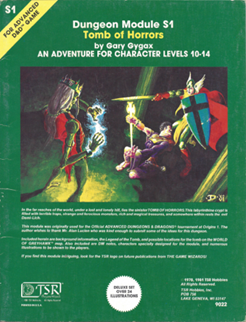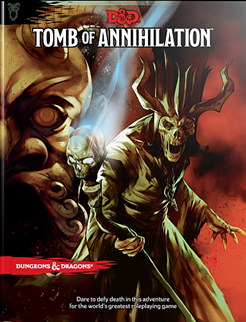 I recently ran a session of Tomb of Horrors. Not the new version from Tales from the Yawning Portal, but the old version. The AD&D first edition version. With the pregenerated characters included in the adventure. Seven players, seven heroes. In a two-hour session they reached about half-way through.
I recently ran a session of Tomb of Horrors. Not the new version from Tales from the Yawning Portal, but the old version. The AD&D first edition version. With the pregenerated characters included in the adventure. Seven players, seven heroes. In a two-hour session they reached about half-way through.
The dwarven fighter began the session on 90 hit points, a very good total in those days. At the end of the session, having found almost every pit trap to fall into, he was on 30 hit points. And the clerics were almost out of healing spells. I think one might have a heal spell and a cure light wounds spell – but the remainder of their spells were gone – especially the three neutralise poison spells!
This is a feature of AD&D (and original D&D before it). Healing is very, very limited, and playing the game again reinforced that, especially as I made the spell choices for the party. I wanted a mix of utility and combat spells. This left the seven characters as follows for AC, hit points and spells:
Magic-User 14: HP 42, AC 6; comprehend languages, detect magic, magic missile (x2), burning hands; invisibility, knock (x2), levitate, web; dispel magic (x2), fly, fireball, lightning bolt; dimension door, fire shield, ice storm, remove curse; cone of cold, teleport, wall of force, cloudkill; disintegrate, flesh to stone; limited wish
Cleric 14: HP 71; AC -5; detect magic (x2), cure light wounds (x3), bless, protection from evil, remove fear; augury (x2), find traps (x2), resist fire (x2), spiritual hammer (x2); dispel magic (x2), remove curse (x2), prayer, speak with dead, continual light; cure serious wounds (x3), neutralise poison (x2), exorcise; cure critical wounds, raise dead (x2); heal, blade barrier
Ranger 14: HP 90; AC -4; detect magic, purify water; cure light wounds; spider climb, magic missile; detect invisibility
Fighter 9: HP 90; AC -1
Cleric 5/Ranger 7/Magic-User 6: HP 34; AC -1; cure light wounds (x3), protection from evil, remove fear; find traps, resist fire (x2), spiritual hammer (x2); dispel magic, remove curse; detect magic, magic missile x2, shield; continual light, knock; dispel magic, lightning bolt
Magic-User 7/Thief 9: HP 30; AC 1; charm person, jump, read magic, comprehend languages; knock (x2), web; dispel magic, lightning bolt; ice storm
Fighter 4/Illusionist 5: HP 28; AC 0; dancing lights; light; detect invisibility; detect illusion; fog cloud, invisibility; invisibility 10′ radius
The total healing spells?
- Cure Light wounds (7) – 1d8 healing each
- Cure Serious Wounds (3) – 2d8+1 healing each
- Cure Critical Wounds (1) – 3d8+3 healing
- Heal (1) – restores all hit points except 1d4
Total hit points in the party? 385. Average points of healing? 78 plus one heal.
This felt so alien compared to the play of 5E, where hit points are restored at the drop of a hat. It breeds a definite sense of caution (if not terror). Consider also that dropping to 0 hit points in some versions of the game meant death, not just unconsciousness, and the desire to have as good protection as possible is very understandable.
 I’ve just finished running Tomb of Annihilation, and although there are some extremely dangerous encounters, the threat of character death never felt as real as in Tomb of Horrors. Even the famed sphere of annihilation is watered down. The stats in AD&D? If you’re touched by it, you’re annihilated. In 5E? Only 4d10 damage (which you get to save against with a relatively easy DC 13 Dexterity save).
I’ve just finished running Tomb of Annihilation, and although there are some extremely dangerous encounters, the threat of character death never felt as real as in Tomb of Horrors. Even the famed sphere of annihilation is watered down. The stats in AD&D? If you’re touched by it, you’re annihilated. In 5E? Only 4d10 damage (which you get to save against with a relatively easy DC 13 Dexterity save).
One of the best one-two punches in Tomb of Annihilation was lessened by the healing magic on offer. A cursed item inflicted 50 damage on the entire party – enough to almost kill most of them. The druid cast spirit of healing (a level 2 spell), and they were all restored to full health. The next trap – activating just after the healing spell – again inflicted 50 damage on the foolish character that triggered it. Another spirit of healing and all was better.
Do I think the game would be improved by a return to the extremely limited healing of AD&D? Not really. However, I’m very concerned by the way the design of D&D has gone. The assumption is that players are able to restore all hit points between encounters; thus, for an encounter to be challenging, it needs to have the potential of killing the characters.
If the DM gets things wrong, either the players don’t feel challenged, or some of the characters die.
From the player side of things, if they don’t have the resources to fully heal, then they shouldn’t continue: the next encounter, which assumes they’re on full hit points, is very likely to kill them.
I’m uneasy about this state of affairs.
Can a group keep going whilst wounded? What’s the balance between attrition-based play and full-restore play? Where can you have lesser encounters, and how much do they drain the resources of the players?
My home game uses a house rule that whenever a PC drops to 0 hit points, they gain a level of exhaustion that lasts until they’re restored to full hit points (or take a long rest, much the same thing!) This stops the yo-yo syndrome of constant healing words keeping someone on 0 hit points in the fight; there’s a definite cost for allowing all your hit points to be depleted.
I’m still struggling with the amount of healing on offer in 5E. I’m not sure where a good point is to balance it!

I, too, struggle with this, and have for many years. My recently launched weekly Labyrinth Lord game (basic D&D retroclone) has brought the issue to the forefront of my mind again. Death is simply accepted in basic D&D, partly because at 0 HP you die, and partly because the time it takes to create a PC is so very short. It isn’t a loss of a huge investment when a 1st or 2nd level PC dies. At higher levels it hurts a bit more, but it is an accepted part of the game, so no one whinges too much.
In post 2e D&D, that is not the case – the chargen process is involved and it is expected that a PC will live into the higher levels, partly because of the attempt at game balance (ok in 3e, extreme in 4e, ok in 5e) that bred the idea that each encounter should be won by the PCs if they don’t all roll poorly or make huge tactical mistakes.
In my 5e game I incorporate the following house rules to make healing a more considered resource:
1) No resurrection in my homebrew world (except through extreme means). This seems harsh, but it gives weight to the possibility of death. No one shrugs and just assumes they will pay 500gp and get revived.
2) Any PC that drops to 1/8 their total HP or lower gains a level of exhaustion, which remains until the PC comes back to full health and has had a long rest.
3) Healing potions in my homebrew world are not as easy to come by as in the published worlds. Some low magic healing herbal slaves are readily available, but they only heal 1d3 HP and the components might not be available depending on season and location. Using too much can make the PC sick, as well, so there are drawbacks to this healing method.
Ooh – that certainly changes things!
Great article. I think I’ll adopt the level of exhaustion after a PCs drops to 0 hit points.
I believe these changes reflect those that have taken place in society over the last 40 odd years. Today, everyone is expected to be a winner, and feeling comfortable and having fun (which you can obviously only do if success is handed to you) are paramount. Risk, challenge, and truly overcoming adversity are placed on back-burners.
Wow, I completely disagree with the Tomb of Annihilation. First, I’m not allowing my party a long rest until they achieve certain conditions, so it will feel like they are being pushed to the limits in terms of spells and the ability to heal. While I agree it makes encounter balancing different, PCs should not be getting short rests after each encounter, especially not at Tier 2+. I think that is the biggest misunderstood flaw in the game. Short rests should be after 2-3 encounters, not 1. Also helps to balance the classes with each other.
Martin, what do you mean you don’t allow them rests? Is that just DM fiat or do you have some in-game threat that prevents them from resting?
Correct. There would be an in-game threat that would prevent. Not a huge fan of DM fiat making it harder, but also want to use the tools of the Tomb to keep the PCs on edge.
Whilst I’m not familiar with either Tombs, the general point you make that healing is too easy is a bone of contention for me too. I homebrewed a different system (http://www.hipstersanddragons.com/better-healing-rules-5e-dnd/) which I think works well, whilst recently our DM – very similar to your own house rule – started giving PCs two levels of exhaustion every time they drop to 0 hit points.
At the very least I think it’s best to use the “Slow Natural Healing” variant in the DMG, although the name doesn’t fit the mechanic as it still allows for fast supernatural healing during a short rest… you just have to burn up your daily hit die allowance to do it.
You might consider this variant as well: http://ragingowlbear.blogspot.com/2018/04/dnd-5e-slower-healing.html?m=1